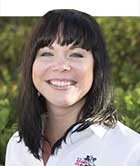 Flies become a nuisance in the summer, especially for our cattle. An unmanaged fly population can reduce milk production 10 to 30 percent and decreases feed efficiency. While we'll never be able to eliminate flies completely, there are some control measures that minimize their impact on the herd.
Flies become a nuisance in the summer, especially for our cattle. An unmanaged fly population can reduce milk production 10 to 30 percent and decreases feed efficiency. While we'll never be able to eliminate flies completely, there are some control measures that minimize their impact on the herd. The most common types of flies on dairies are horn flies, face flies, stable flies and houseflies. Each type of fly can be found on a different area of the animal. Be sure you identify which flies you have present in order to use the control method most effective for that species. Horn flies are typically found on the shoulders, back and sides of cattle. Face flies are generally clustered around the eyes and nose. Stable flies feed primarily on the legs and may be found on the belly. Houseflies are commonly found in animal housing areas, the milk house or parlor.
Good sanitation standards are the most effective and proactive ways to control all types of flies. Flies breed in manure and other moist decaying organic matter like spilled feed or wet straw. By practicing good sanitation, you'll cut down the rapid breeding cycle. Be sure to clean near feed troughs, waterers and anywhere damp feed or bedding may accumulate and decay. Those areas should be cleaned at least once per week, removing all organic matter and maggots to prevent further breeding. Manure can be piled, dried or spread minimizing its contribution to the fly problem.
Other options for fly control include biological control with bluebirds or barn swallows that eat hundreds of flies per day. Create a habitat these birds are comfortable in to encourage them to stick around your dairy. Fly strips can be hung across the length of the barn and monitored for the number of adult flies captured. Chemical control can be used with foggers, dusters and back rubs; however, be sure that any chemicals are approved for lactating dairy cows.

The author, Ali Enerson, was the special publications editor, responsible for books, plans, distribution of the e-newsletter and various internal communication pieces. She grew up on a 60-cow dairy in northwest Wisconsin, and is a graduate of University of Wisconsin–Madison with a degree in life sciences communications.









